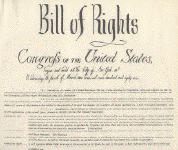 |
U.S. Constitution and Your Rights Founding fathers George Mason, Thomas Paine, and Patrick Henry argued that a set of rights for citizens should be clearly written in the U.S. Constitution of 1789. They were disappointed when that did not happen. After the U.S. Constitution was adopted, many Americans felt it was important to protect the individual citizen's rights. |
When the first Congress met in 1789, they debated and passed 12 amendments. On December 15, 1791, the United States of America ratified ten of these amendments. They are now called the Bill of Rights.
These web sites will assist you in answering these questions. U.S. Constitution - Bill of Rights | The Avalon Project at Yale - digital documents related to the American Constitution | Primary Documents in American History at the Library of Congress. | The Story of the Bill of Rights Videos | Liberty's Kids - We the People videos | Bill Of Rights Institute
1. Write the First Amendment of the U.S. Constitution.
Give an example of how it applies to you.
2. Write the Sixth Amendment in your own words.
Give an example of when this would be very important to a person.
3. The Ninth Amendment was James Madison's answer to critics
of the list of rights he wanted to add to the Constitution.
What does
the Ninth Amendment guarantee?
4. The President frequently offers an opinion about legislation being proposed and debated in Congress.
What was the opinion of the President during the debates on the first twelve amendments to the U.S. Constitution?
Would you have supported his opinion?
5. It is argued that the U.S. Government's: reading of your
emails, listening to your phone calls
and checking out which books you
have read at the library (Patriot
Act), violates your rights under the Constitution.
Which of the Bill of Rights Amendments do these actions violate?
Should the government be allowed to do this? Explain.
6. Federal law requires schools to tell students their free speech rights at school. What is your school's policy?
Extend your knowledge: Investigate Voting rights.
1. Abigail Adams urged her husband John Adams to “remember the ladies” when he served as the 2nd President of the United States. Unfortunately, the government chose to deny women the right to vote.
Which amendment gives women the right to vote?
When were women finally afforded the right to vote?
For how many years have women been permitted to vote in the United States of America?
2. Which amendment(s) to the Constitution would be particularly important to Rosa Parks? Explain.
3. What argument was used to support the 26th Amendment?
Do you agree with it or dispute it? Explain.
How are Norman Rockwell's Four Freedoms emblematic of the Bill of Rights? - research then respond.
"As a man is said to have a right to his property,
he may be equally said to have a property in his rights." James Madison
Done already? Excellent!
| History Mystery Message project | Honor a suffragist |
| Complete this essay - The people made the Constitution | Explore Congress for Kids The Constitution |
| Youth Voter project | Ben's Guide to the US Government |
| Bill of Rights Song | |
| Constitution ms/hs | First Amendment | Elections & Voting | Civics & Government Studies |
Internet Hunts / Nature / Computers / Puzzles & Projects / Pennsylvania Projects / Problem Based Learning / Site map / Home
All trademarks, copyright and logos belong to their respective owners.
posted 9/2005 revised 12/2019 by Cindy O'Hora
Released to public domain in honor of the founding mother, Abigail Adams.
![]() Save a tree - use a Digital Answer Format - Highlight the text. Copy it. Paste it in a word processing document. Save the document in your folder. Answer on the word processing document in a contrasting color (not yellow) or font (avoid
Save a tree - use a Digital Answer Format - Highlight the text. Copy it. Paste it in a word processing document. Save the document in your folder. Answer on the word processing document in a contrasting color (not yellow) or font (avoid ![]() ,
, ![]()
![]() or other ornate artistic fonts). Save frequently as you work. Be sure to enter your name & the date at the top of the document. Submit via email attachment or class dropbox. Bad things happen: Save a copy of the response document for your records.
or other ornate artistic fonts). Save frequently as you work. Be sure to enter your name & the date at the top of the document. Submit via email attachment or class dropbox. Bad things happen: Save a copy of the response document for your records.
Proof read your responses. It is funny how speling errors and typeos sneak in to the bets work. ![]() | How to: Make your own printer ready paper answer sheet with lines.
| How to: Make your own printer ready paper answer sheet with lines.